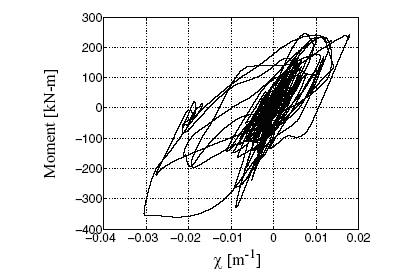

A nonlinear finite element of this bridge site including the bridge structure, pile group and supporting foundation soil, is developed and 2D plane strain conditions. This project studies the effects of specially input excitation at an existing bridge site. Nonlinear modeling and analysis allows more accurate determination of stresses, strains, deformations and forces of critical components results than can be used for the final design of the bridge system. The idealized model should properly represent the actual geometry, boundary, conditions, and gravity load distribution. The seismic demands of a bridge structure subjected to a particular ground motion can be estimated through an equivalent analysis of a mathematical model that incorporates the behavior of the superstructure, piers, footing and soil system. Performing the bridge simulation on C-DAC’s Param Yuva facility results in accuracy and saving in computing efforts. The results include deformations at base of piers and at various spans of the bridge. The earthquake simulation of bridge structure includes large scale interaction between structure–foundation–soil system and deformations at various locations of the bridge. Seismic input motions are defined as forces using the boundary layer force method (zero length element approach). Carefully calibrated nonlinear stress–strain models are employed for both bridge and soil materials, in order to realistically reproduce actual site conditions. A nonlinear finite element model of this bridge site including the bridge structure, pile group and supporting foundation soil is developed in 2D plane strain conditions and in 3D 20 noded brick element. The present work involves the effects of specially varying input excitation (earthquakes) at an existing bridge site. Nonlinear modeling and analysis allows more accurate determination of stresses, strains, deformations and forces of critical components. The idealized model properly represents the actual geometry boundary conditions, gravity loads and mass distribution. The ground motion selection and modification technique-predicting median interstory drift response of building, ground motions are selected by M and R and scaling to Sa( T1), is used for seismic response of combined large scale soil-structure interaction of Karad bridge. The earthquake simulations were carried out using C-DAC’s high performance computing facilities.
#3d earthquake loading opensees software
OpenSees is open source software for carrying out earthquake engineering simulations, developed by Pacific Earthquake Engineering Research Centre, USA. The computational model is analyzed using Parallel OpenSees. A nonlinear finite element model of existing bridge at Karad, India, including the bridge structure, pile groups, and the supporting foundation soil, is developed under 2D and 3D conditions in Gid (a pre and postprocessor software).

#3d earthquake loading opensees code
I want to be able to change and manage the Newmark beta or State space code in MATLAB for doing Semi-active control civil Structures.Nonlinear seismic analysis is becoming increasingly significant to grasp the performance of structures under earthquake.

I want to model a multi degree of freedom structure against earthquake with rotational friction damper in OpenSEES and link OpenSEES with MATLAB for Time History Nonlinear analysis with Newmark Beta or State Space method.


 0 kommentar(er)
0 kommentar(er)
